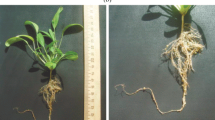Summary
An indirect isotopic method was developed to estimate N2 fixation by legume grown in pots. Two pasture legumes, subterranean clover and barrel medic, and one Australian native legume, silver wattle, were grown in a N2-depleted atmosphere of Ar:O2:CO2 (77:20:3) for a short period of time following addition of15N-labelled KNO3 (8 mg N pot−1). Uptake of fertiliser-N by these plants was compared with that of plants receiving the same amount of15N-labelled NO3 − but grown under a normal N2 atmosphere. Symbiotically fixed N2 was calculated from the difference in fertiliser-N uptake by plants in the Ar and N2 atmospheres, based on the assumption that the nitrogen requirement of the legumes grown in the former atmosphere was satisfied by an equivalent uptake of labelled NO3 −−N from the soil.
The percentage decrease in C2H2 reduction activity of the legumes following the addition of KNO3 was relatively constant. The C2H2:N2 molar ratios for subterranean clover, barrel medic and silver wattle were 5.2, 5.8 and 2.8, respectively. A large proportion (50 to 60%) of the electron flux available for N2 fixation by the pasture legumes was used for the evolution of H2. The (C2H2−H2):N2 ratios were close to the theoretical value of 3∶1. The total soil-plant system did not evolve H2, but instead was capable of taking up exogenously supplied H2, which was stimulated by the presence of the legumes.
Similar content being viewed by others
References
Allos H F and Bartholomew W V 1959 Replacement of symbiotic fixation by available nitrogen. Soil Sci. 87, 61–66.
Bennett D J 1967 Analysis fo gas mixtures by gas chromatography. J. Chromatog. 26, 482–484.
Bergersen F J 1970 The quantitative relationship between nitrogen fixation and the acetylene reduction assay. Aust. J. Biol. Sci. 23, 1015–1025.
Bremner J M and Edwards A P 1965 Determination and isotope-ratio analysis of different forms of nitrogen in soils: I. Apparatus and procedures for distillation and determination of ammonium. Soil Sci. Soc. Amer. Proc. 29, 504–507.
Conrad R and Seiler W 1979 Field measurements of hydrogen evolution by nitrogen-fixing legumes. Soil Biol. Biochem. 11, 689–690.
Edmeades D C and Goh K M 1979 The use of the15N-dilution technique for field measurement of symbiotic nitrogen fixation. Comm. Soil Sci. and Plant Analysis 10, 513–520.
Fried M and Broeshart H 1981 A further extension of the method for independently measuring the amount of nitrogen fixed by a legume crop. Plant and Soil 62, 331–336.
Gibson A H, Dreyfus B L, Lawn R J, Sprent J I and Turner G L 1981 Host and environmental factors affecting hydrogen evolution and uptake. p. 373.In Current Perspectives in Nitrogen Fixation. Eds A H Gibson and W E Newton. Australian Academy of Science, Canberra.
Goh K M, Edmeades D C and Robinson B W 1978 Field measurements of symbiotic nitrogen fixation in an established pasture using acetylene reduction and a15N method. Soil Biol. Biochem. 10, 13–20.
Hardy R W F, Burns R C and Holsten R D 1973 Applications of the acetylene-ethylene assay for measurement of nitrogen fixation. Soil Biol. Biochem. 5, 47–81.
Hopmans P, Chalk P M and Douglas L A 1983 Symbiotic N2 fixation by legumes growing in pots: I. Fixation of15N-labelled N2 and C2H2 reduction byTrifolium subterraneum L. Plant and Soil 74, 325–332.
Hopmans P, Douglas L A and Chalk P M 1982 Estimation of nitrogen fixation byTrifolium subterraneum L. andMedicago trucatula Gaertn. grown in pots using a non-destructive acetylene reduction assay. Soil Biol. Biochem. 14, 495–500.
Hudd G A, Lloyd-Jones C P and Hill-Cottingham D G 1980 Comparison of acetylene-reduction and nitrogen-15 techniques for the determination of nitrogen fixation by field bean (Vicia faba) nodules. Physiol. Plant. 48, 111–115.
LaRue T A and Patterson T G 1981 How much nitrogen do legumes fix? Adv. Agron. 34, 15–38
MacFadyen A 1970 Simple methods for measuring and maintaining the proportion of carbon dioxide in air, for use in ecological studies of soil respiration. Soil Biol. Biochem. 2, 9–18.
Nelson D W and Sommers L E 1973 Determination of total nitrogen in plant material. Agron. J. 65, 109–112.
Rennie R J 1979 Comparison of15N-aided methods for determining symbiotic dinitrogen fixation. Rev. Ecol. Biol. Sol. 16, 455–463.
Rennie R J 1982 Quantifying dinitrogen (N2) fixation in soybeans by15N isotope dilution: the question of the non-fixing control plant. Can. J. Bot. 60, 856–861.
Richards J E and Soper R J 1979 Effect of N fertilizer on yield, protein content, and symbiotic N fixation in Faba beans. Agron. J. 71, 807–811.
Ruschel A P, Vose P B, Matsui E, Victoria R L and Tsai Saito S M 1982 Field evaluation of N2 fixation and N-utilization by Phaseolus bean varieties determined by15N isotope dilution. Plant and Soil 65, 397–407.
Saito S M T, Matsui E and Salati E 198015N2 fixation, H2 evolution and C2H2 reduction relationships inPhaseolus vulgaris. Physiol. Plant. 49, 37–42.
Schubert K R and Evans H J 1976 Hydrogen evolution: A major factor affecting the efficiency of nitrogen fixation in nodulating symbionts. Proc. Nat. Acad. Sci. USA 73, 1207–1211.
Smith C J and Chalk P M 1979 Nitrogen gas preparative system for isotope-ratio analysis by mass spectrometry. Analyt. Chim. Acta 104, 245–252.
Trinick M J, Dilworth M J and Grounds M 1976 Factors affecting the reduction of acetylene by root nodules ofLupinus species. New Phytol. 77, 359–370.
Vallis I, Haydock K P, Ross P J and Henzell E F 1967 Isotopic studies on the uptake of nitrogen by pasture plants. III. The uptake of small additions of15N-labelled fertilizer by Rhodes grass and Townsville lucerne. Aust. J. Agric. Res. 18, 865–877.
Author information
Authors and Affiliations
Rights and permissions
About this article
Cite this article
Hopmans, P., Chalk, P.M. & Douglas, L.A. Symbiotic N2 fixation by legumes growing in pots. Plant Soil 74, 333–342 (1983). https://doi.org/10.1007/BF02181351
Received:
Revised:
Issue Date:
DOI: https://doi.org/10.1007/BF02181351



